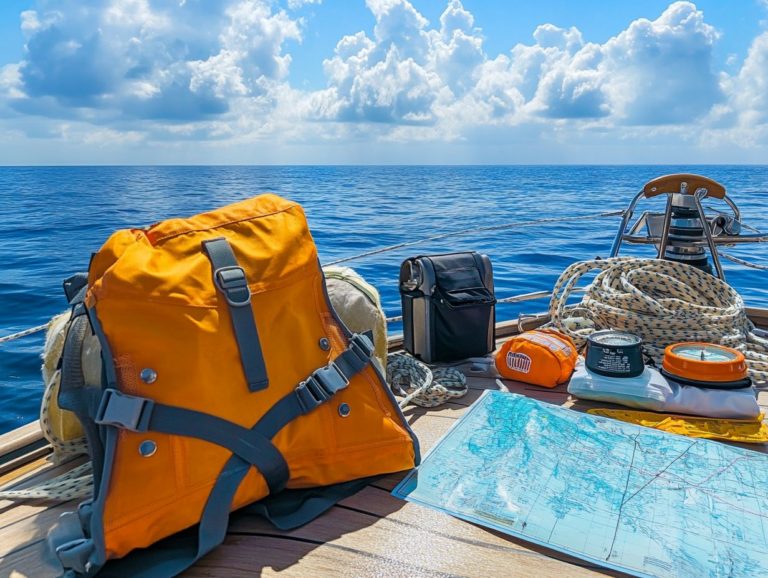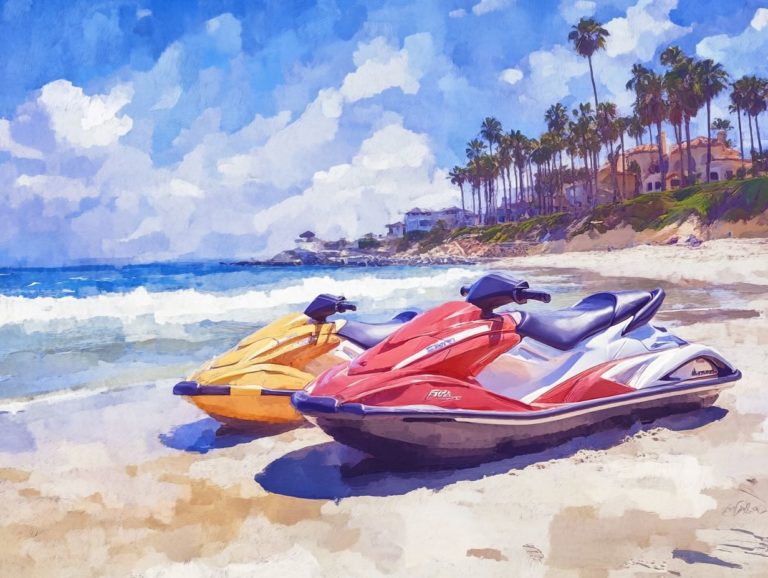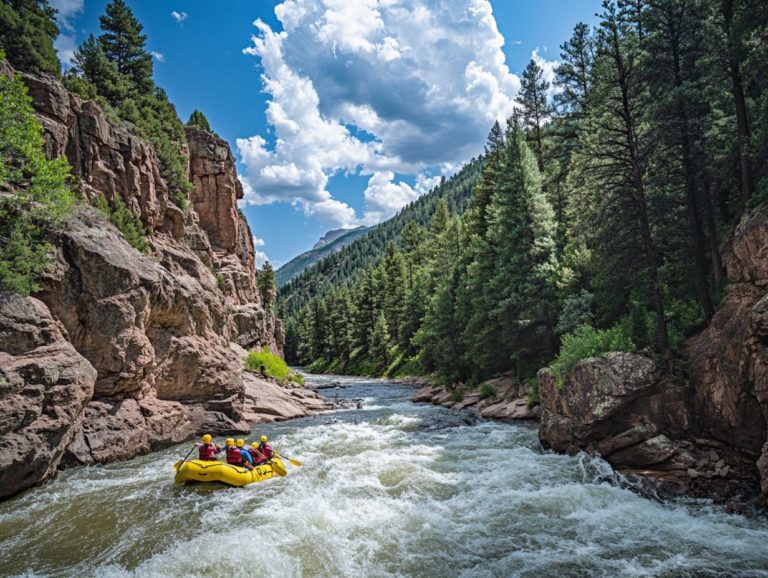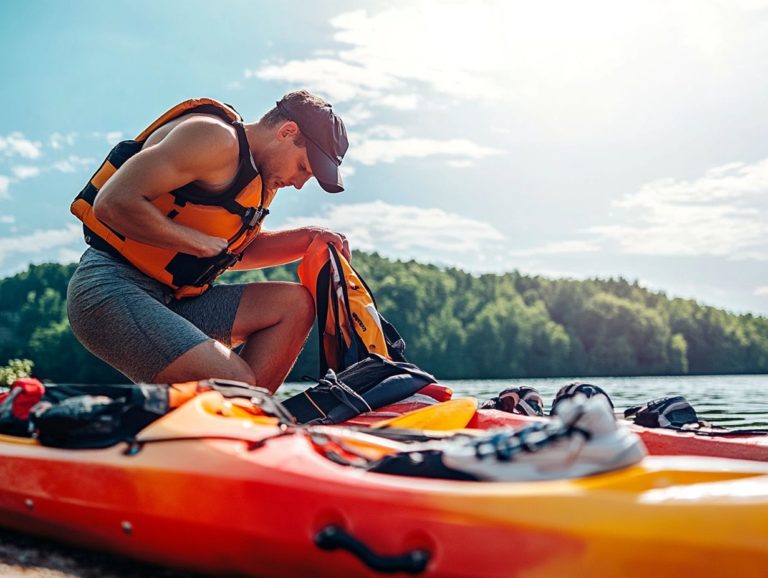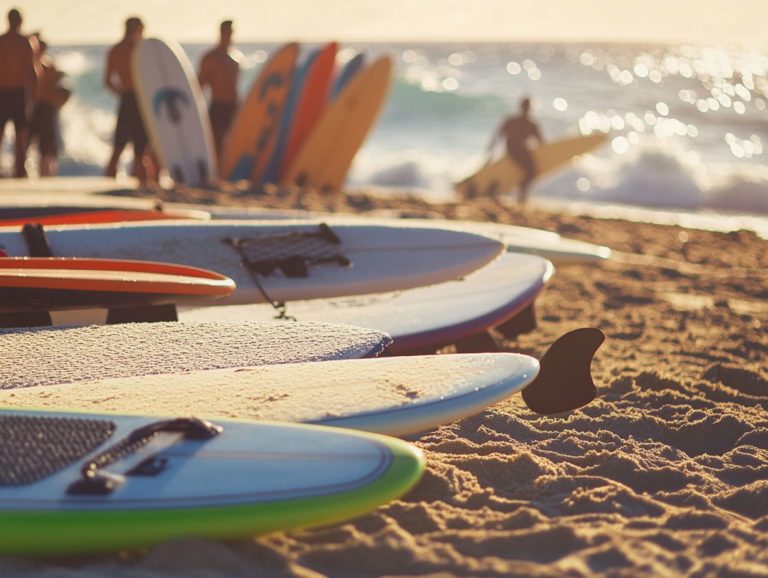5 Essential Tips for Surfing Beginners
Surfing is not just a thrilling sport; it s a lifestyle that immerses you in the ocean, providing a wealth of physical and mental benefits.
Whether you’re captivated by the thrill of catching waves or the tranquil beauty of the sea, this guide is tailored for you.
It will cover everything you need to start your surfing journey, from essential gear and safety tips to selecting the ideal surf spot and improving your skills.
You’ll also learn about the importance of etiquette within the surfing community. Dive in and discover how you can ride the waves with confidence!
Contents
- Key Takeaways:
- What is Surfing?
- Benefits of Surfing
- Getting Started with Surfing
- Choosing the Right Surf Spot for Beginner Surfers
- Improving Your Surfing Skills
- Maintaining Proper Surfing Etiquette
- Frequently Asked Questions
- What are the 5 essential tips for surfing beginners?
- How do I choose the right surfboard as a beginner?
- What are some paddling techniques I should learn as a beginner?
- How can I practice my pop-up as a beginner?
- How do I read the waves as a surfing beginner?
- What should I prioritize for safety as a surfing beginner?
Key Takeaways:
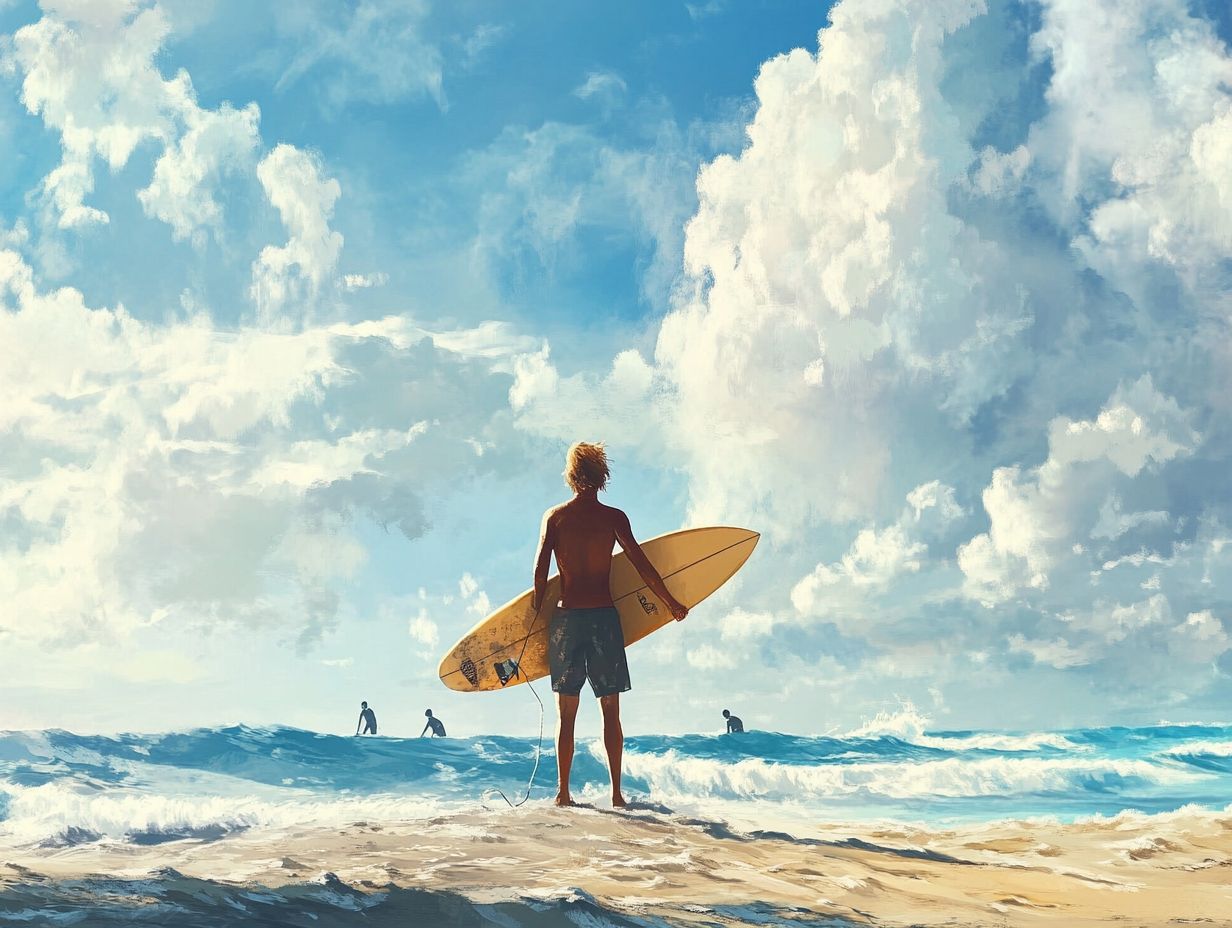
- Invest in proper equipment and gear to ensure a safe and enjoyable surfing experience.
- Select a suitable surf spot by considering wave height, type, and crowd level.
- Surfing offers mental benefits such as stress relief and improved focus and concentration.
What is Surfing?
Surfing is a water sport that invites you to ride the ocean waves on a surfboard. As you paddle out for those perfect swells, you ll feel the thrill of gliding across the water. Beyond the excitement, surfing fosters a deep connection with nature and the ocean. With its different styles and techniques, it has become a beloved activity for enthusiasts at every level.
Whether you’re a beginner trying to ride your first wave or someone eager to refine your skills, surf schools and camps offer guided lessons and equipment to help you.
Originating in ancient Polynesia, surfing was more than a sport; it was part of cultural identity, showcasing the artistry of local communities. Over time, surfboards evolved from wooden structures to modern foam and fiberglass designs, enhancing performance and accessibility.
As surfing gained popularity in the 20th century, it grew from regional roots into a global movement, uniting a vibrant community fueled by shared passion. Today, surfers like you seek adventure in diverse settings, equipped with an array of surf gear tailored to different conditions, solidifying surfing as a cherished lifestyle worldwide.
Benefits of Surfing
Surfing offers incredible benefits you won t want to miss! It profoundly influences both your physical and mental well-being.
This sport builds a vibrant community among surfers, fostering lasting friendships. Physically, you ll enjoy enhanced cardiovascular health, increased muscle strength, and improved flexibility, thanks to the demands of paddling and balancing on your surfboard.
On a mental level, surfing is a powerful stress reliever that sharpens focus and promotes mindfulness as you immerse yourself in the ocean’s rhythm and wave patterns.
Physical and Mental Benefits
The physical benefits of surfing are remarkable. You ll see improved endurance and strength, along with enhanced coordination and balance, while engaging in the vibrant surfing community. Surfing provides a full-body workout that boosts your overall fitness levels.
Mentally, the challenges of the ocean sharpen your focus and boost your confidence, leading to transformation in both body and mind.
Through essential surf practices, such as effective paddling techniques, you ll develop strong arms and core stability key for navigating turbulent waters. Paddling acts as dynamic cardiovascular exercise, raising your heart rate and enhancing lung capacity. This rhythmic effort cultivates mindfulness, helping you immerse yourself in the present and leave worries behind.
Engaging with the ocean nourishes your body and boosts your emotional well-being. It s vital to understand ocean knowledge for a safer and more enriching surfing experience.
Getting Started with Surfing
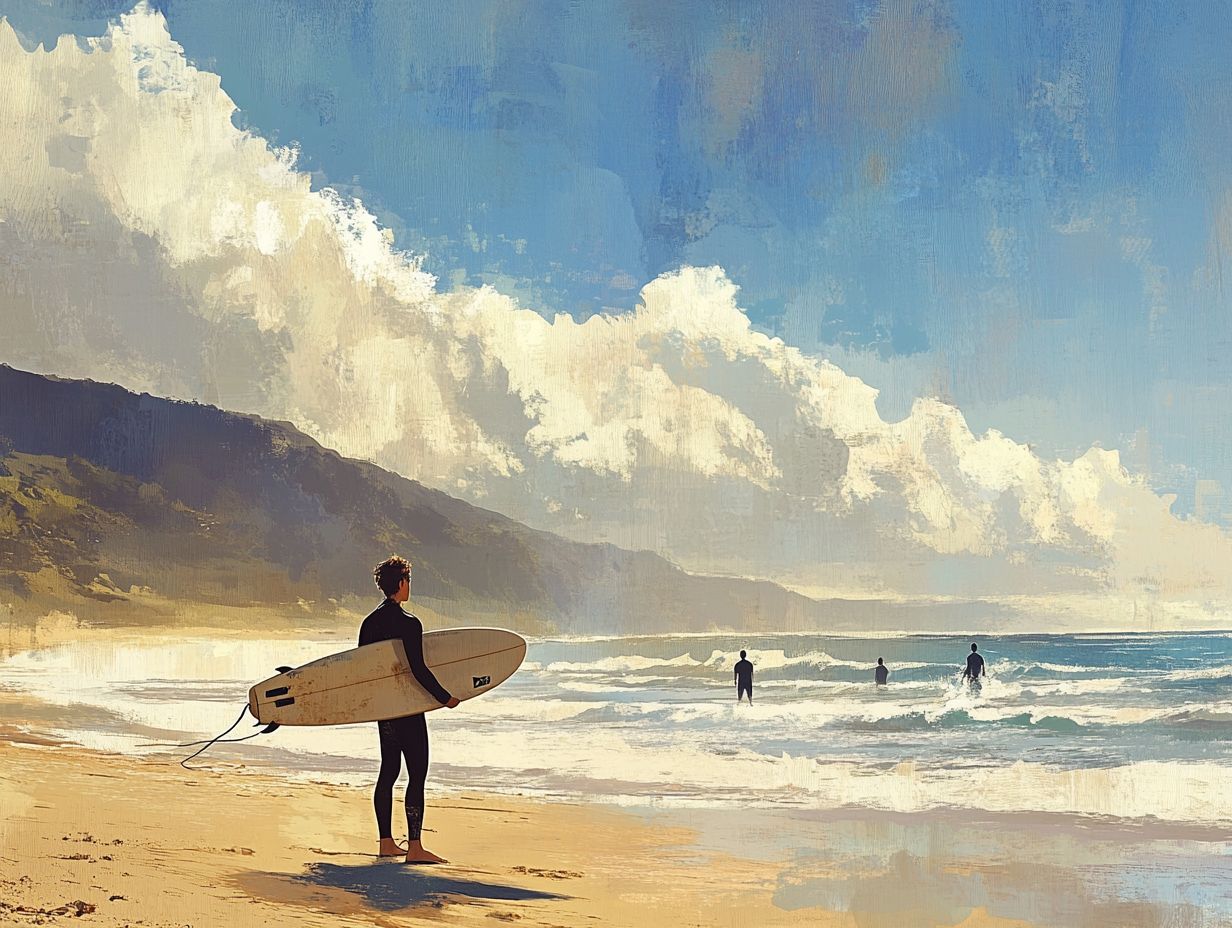
Embarking on your surfing journey can be an exhilarating experience, especially for those eager to connect with the ocean’s rhythm. Your first step is to enroll in a reputable surf school or camp for tailored lessons that match your skill level.
Choosing the right surf equipment is vital for an enjoyable experience. This means selecting the perfect surfboard, wetsuit, leash, and fins that prioritize your comfort and safety as you ride the waves.
Understanding surf conditions is key to your success. Learning about the ocean will help you significantly in your surfing journey.
Necessary Equipment and Gear
Having the right surf gear is crucial for a successful experience, especially for beginners. Key items include a beginner-friendly surfboard, a wetsuit to keep you warm and protected, a leash to secure your board, and fins to enhance your maneuverability.
When choosing your surfboard, consider your body size and skill level. If you’re larger, a thicker, wider board will provide the stability you need.
For novices, boards with more volume will make your ride much more enjoyable. Safety is paramount; always wear a leash to prevent losing your board and to avoid injuries.
Regular maintenance of your surf gear is equally important. Rinse your wetsuit and check your fins for damage to prolong your equipment s life. Staying informed ensures every surf session is safe and enjoyable.
Basic Techniques and Safety Tips
Mastering the basics is your ticket to an exhilarating surfing adventure! This includes honing vital skills like paddling technique and finding your balance on the surfboard.
Understanding surf etiquette fosters harmony within the surfing community. Familiarize yourself with the ocean’s wave dynamics and current conditions to stay safe while practicing your new skills.
To paddle effectively, focus on your stroke technique. Aim for smooth and consistent movements to maintain your speed and momentum.
Positioning on the board is key; sitting too far forward or back can lead to instability. For those looking to enhance their skills, check out the top 10 tips for effective stand-up paddleboarding. Be aware of common safety issues, like the dangers of rip currents, which are strong currents that can pull you away from shore, and always wear a leash.
Adhering to surf etiquette like waiting for your turn and respecting fellow surfers’ space creates a welcome environment for everyone. By following these guidelines, you can enhance your surfing practice and enjoy long-term progression in becoming a more proficient surfer.
Choosing the Right Surf Spot for Beginner Surfers
Selecting the right surf spot is crucial for ensuring a safe and enjoyable experience, especially as you start to master the art of wave reading.
Each surf location has unique conditions shaped by wind direction, tide levels, and swell size. By tapping into the insights of local surfers, you can uncover invaluable recommendations on the best spots and the optimal times to catch the perfect wave.
Factors to Consider
When selecting a surf spot, it’s essential to consider several factors, such as surf conditions and wave dynamics. Understanding how local surfers approach various conditions empowers you to make informed choices about when and where to catch those waves.
Pay close attention to the type of waves whether they re soft and gentle or powerful and demanding and honestly assess your skill level in relation to what s happening at the chosen location. Evaluating water depth is crucial; shallow reefs and rocks can present real hazards.
Don’t underestimate the impact of wave size, either; large swells can easily overwhelm inexperienced surfers, leading to potential dangers. It’s smart to seek advice from local surfers, who often have invaluable insights about crowd levels and safety protocols, especially on busier days. Additionally, consider checking out 5 tips for maintaining your surfboard to ensure your gear is in top shape.
Engaging in conversation with them can elevate your beach experience and enhance your understanding of ocean knowledge and surf safety. By tapping into this local wisdom, you ll be better equipped to navigate the surf environment with confidence and awareness.
Improving Your Surfing Skills
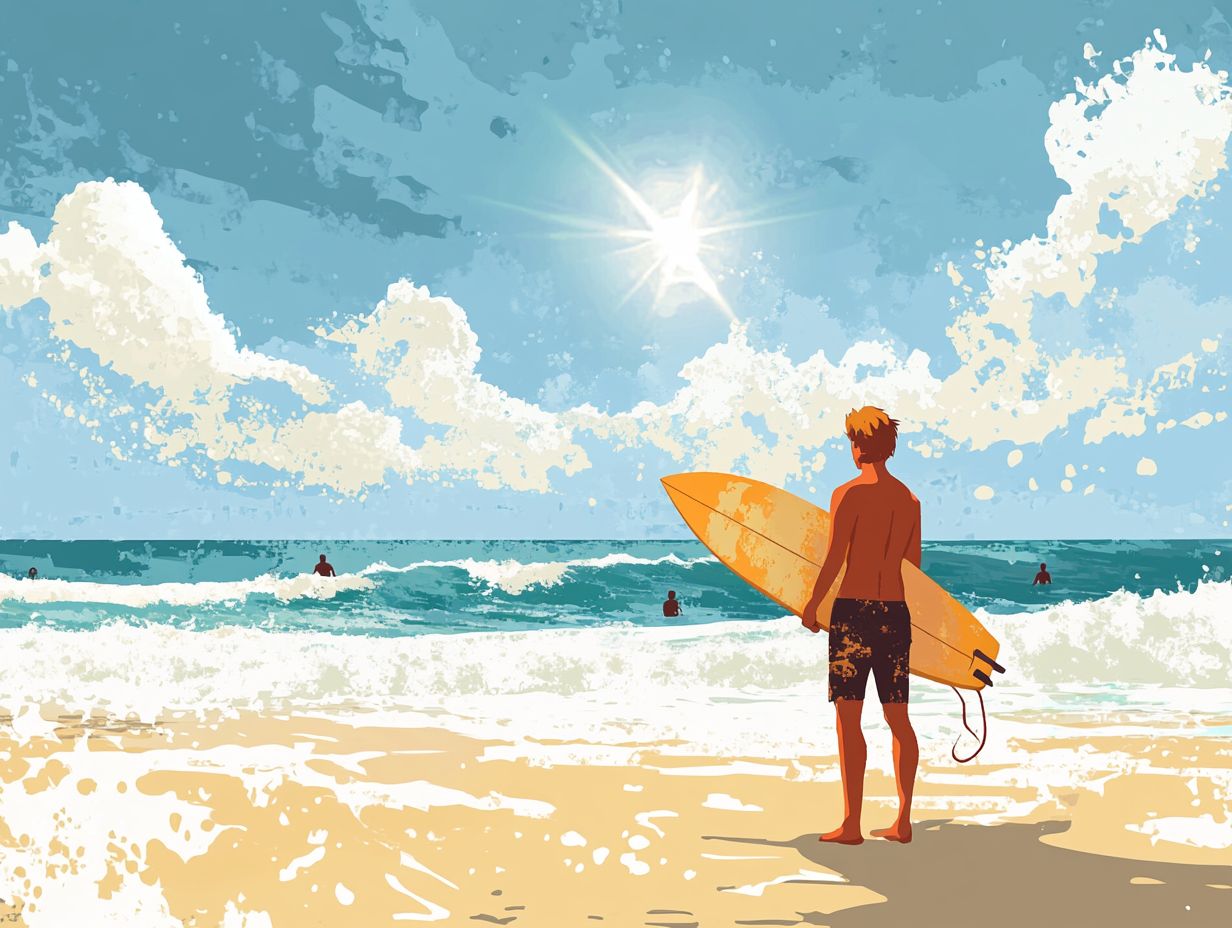
Improving your surfing skills is an ongoing journey that demands dedication and practice. Embrace an openness to learning advanced techniques that will propel your progression.
As you gain confidence on the waves, delve into new surfing tips to fine-tune your approach. This could be perfecting your carving turns or trying jumps.
Regular practice combined with constructive feedback from instructors or seasoned surfers can significantly elevate your skills over time.
Advanced Techniques and Strategies
Now that you ve got the basics down, let s amp up your skills! Once you’ve mastered the basics of surfing, it s time to dive into advanced techniques and strategies that can significantly elevate your performance in the water.
Focusing on optimal paddling angles, which means finding the best way to paddle to catch waves effectively, and efficient wave positioning will help you catch more waves and enhance your overall surfing ability.
Learning from seasoned surfers can offer invaluable insights, allowing you to optimize your practice sessions and refine your techniques. As you explore the sport further, consider 5 tips for beginner surfers that include tube riding inside the wave, like a tunnel, which demands a keen awareness of wave dynamics and impeccable timing.
Navigating various surf conditions, from choppy waters to perfectly glassy waves, becomes crucial for both safety and maximizing your performance. Engaging in review sessions, utilizing video analysis or peer feedback, can sharpen your understanding of your personal style.
This also highlights areas for improvement. Alongside honing your skills, prioritizing surf safety and etiquette fosters a respectful atmosphere in the lineup. For those interested in wakeboarding, incorporating 5 essential tips for wakeboarding can contribute to a positive surfing community and enrich the overall experience for everyone involved.
Maintaining Proper Surfing Etiquette
Maintaining proper surfing etiquette is essential for cultivating a respectful and harmonious atmosphere within the surfing community. By grasping the unspoken rules of the lineup like respecting the priority of those already riding the wave you ensure that everyone can savor their time in the ocean.
Embracing good surf etiquette not only helps you build rapport with local surfers but also allows you to contribute positively to the vibrant surf culture.
Respecting Other Surfers and the Environment
Respecting fellow surfers is essential to surfing etiquette. Always be mindful of others’ space in the water.
Recognize the ocean as a shared treasure. By demonstrating respect for both your fellow surfers and the marine ecosystem, you contribute to a positive surfing culture. This ensures that future generations can enjoy the waves.
One effective way to show respect is by participating in beach clean-ups. Join us in making a change! Remove trash and debris that threaten marine life.
Using your surf equipment responsibly like rinsing your boards and wetsuits to prevent pollution also plays a crucial role in protecting the environment.
As a seasoned surfer, you have a unique opportunity to educate newcomers about proper etiquette and the importance of taking care of the environment. Share valuable insights, such as understanding wave priority rules and how to navigate crowded spots. Additionally, discuss the 5 must-have accessories for surfing to help them enjoy the sport while fostering a community that cherishes both the sport and the ocean.
These collective efforts make your surfing experience better. They align with broader ocean conservation initiatives aimed at preserving our beloved beaches and marine ecosystems.
Frequently Asked Questions
What are the 5 essential tips for surfing beginners?
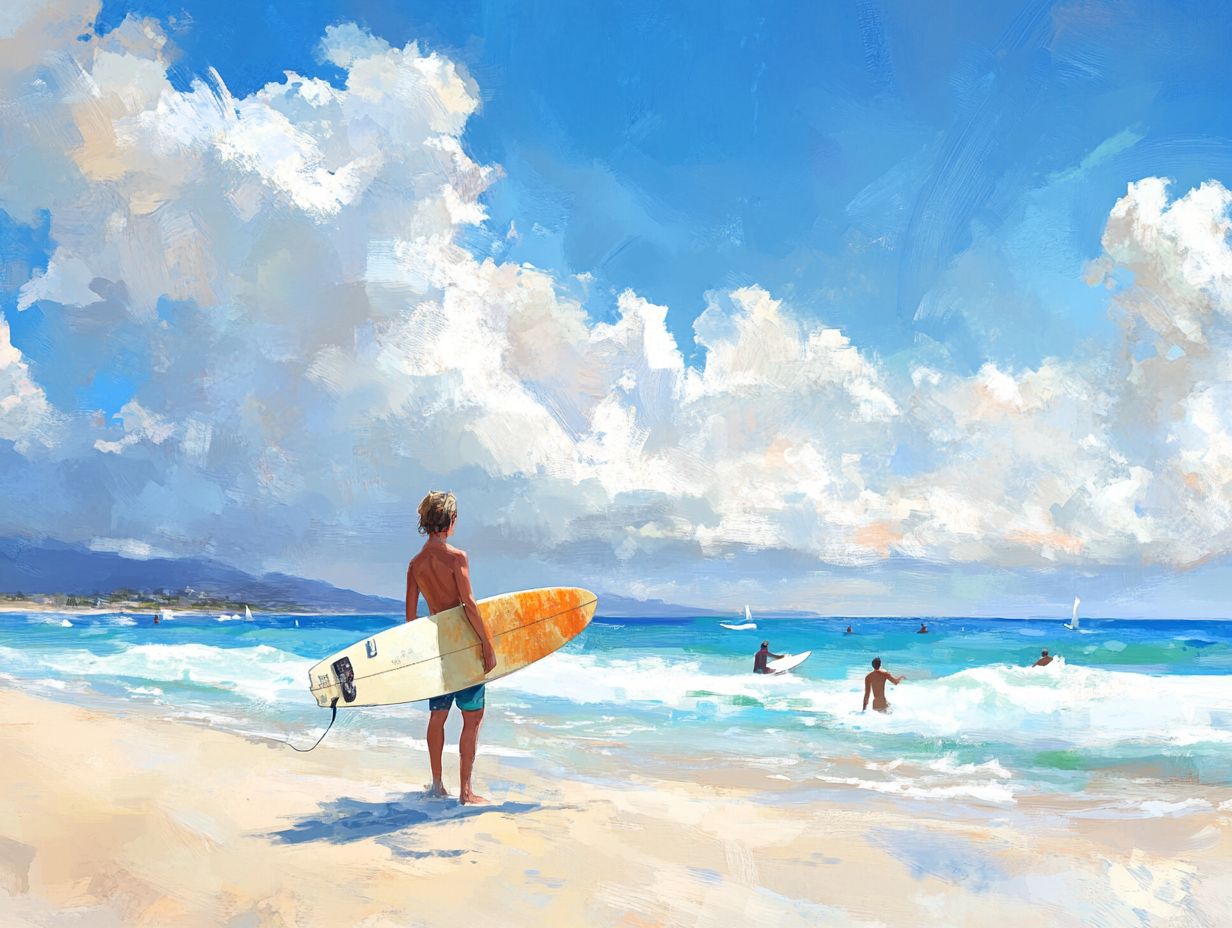
The 5 essential tips for surfing beginners are: 1) Choose the right surfboard, 2) Learn proper paddling techniques, 3) Practice your pop-up, 4) Know how to read the waves, and 5) Always prioritize safety.
How do I choose the right surfboard as a beginner?
As a beginner, it’s crucial to start with a longboard or a foam board. These boards offer stability and are easier to paddle and catch waves with.
Consider your weight and height when choosing a surfboard.
What are some paddling techniques I should learn as a beginner?
Learning proper paddling techniques is crucial! Use full arm motion, keep your upper body still, and engage your core to generate power.
How can I practice my pop-up as a beginner?
A good way to practice is to lie on your board on the sand and simulate the motion of popping up to a standing position. This will help build muscle memory and make it easier on the water.
How do I read the waves as a surfing beginner?
Reading the waves is crucial for surfing. Focus on understanding the basic characteristics of a wave, such as its shape and size.
Learn about the direction it’s breaking to position yourself properly to catch a wave.
What should I prioritize for safety as a surfing beginner?
Safety should always be your top priority when surfing. Always surf in an area with lifeguards, wear a leash, and know your limits.
It’s also helpful to have a buddy system and communicate with other surfers in the water.
Ready to hit the waves? Grab your board and let s go surfing!

